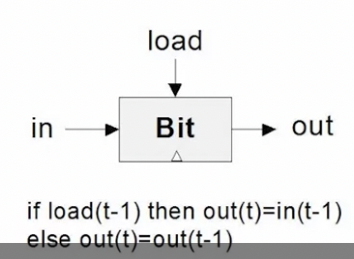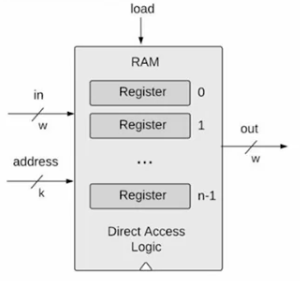// This file is part of www.nand2tetris.org
// and the book "The Elements of Computing Systems"
// by Nisan and Schocken, MIT Press.
// File name: projects/03/a/Bit.hdl
CHIP Bit {
IN in, load;
OUT out;
PARTS:
// Put your code here:
Mux(a=gayout,b=in,sel=load,out=a);
DFF(in=a,out=out,out=gayout);
}
// This file is part of www.nand2tetris.org
// and the book "The Elements of Computing Systems"
// by Nisan and Schocken, MIT Press.
// File name: projects/03/a/PC.hdl
CHIP PC {
IN in[16],load,inc,reset;
OUT out[16];
PARTS:
// Put your code here:
Inc16(in=gayout, out=add);
Mux16(a=gayout, b=add, sel=inc, out=incout);
Mux16(a=incout, b=in, sel=load, out=loadout);
Mux16(a=loadout, b=false, sel=reset, out=resetout);
Register(in=resetout, load=true, out=out, out=gayout);
}
// This file is part of www.nand2tetris.org
// and the book "The Elements of Computing Systems"
// by Nisan and Schocken, MIT Press.
// File name: projects/03/a/RAM64.hdl
CHIP RAM64 {
IN in[16], load, address[6];
OUT out[16];
PARTS:
// Put your code here:
DMux8Way(in=load, sel=address[3..5], a=load0, b=load1, c=load2, d=load3, e=load4, f=load5, g=load6, h=load7);
RAM8(in=in, load=load0, address=address[0..2], out=out0);
RAM8(in=in, load=load1, address=address[0..2], out=out1);
RAM8(in=in, load=load2, address=address[0..2], out=out2);
RAM8(in=in, load=load3, address=address[0..2], out=out3);
RAM8(in=in, load=load4, address=address[0..2], out=out4);
RAM8(in=in, load=load5, address=address[0..2], out=out5);
RAM8(in=in, load=load6, address=address[0..2], out=out6);
RAM8(in=in, load=load7, address=address[0..2], out=out7);
Mux8Way16(a=out0, b=out1, c=out2, d=out3, e=out4, f=out5, g=out6, h=out7, sel=address[3..5], out=out);
}
// This file is part of www.nand2tetris.org
// and the book "The Elements of Computing Systems"
// by Nisan and Schocken, MIT Press.
// File name: projects/03/a/RAM8.hdl
CHIP RAM8 {
IN in[16], load, address[3];
OUT out[16];
PARTS:
// Put your code here:
DMux8Way(in=load, sel=address, a=load0, b=load1, c=load2, d=load3, e=load4, f=load5, g=load6, h=load7);
Register(in=in, load=load0, out=out0);
Register(in=in, load=load1, out=out1);
Register(in=in, load=load2, out=out2);
Register(in=in, load=load3, out=out3);
Register(in=in, load=load4, out=out4);
Register(in=in, load=load5, out=out5);
Register(in=in, load=load6, out=out6);
Register(in=in, load=load7, out=out7);
Mux8Way16(a=out0, b=out1, c=out2, d=out3, e=out4, f=out5, g=out6, h=out7, sel=address, out=out);
}
// This file is part of www.nand2tetris.org
// and the book "The Elements of Computing Systems"
// by Nisan and Schocken, MIT Press.
// File name: projects/03/a/Register.hdl
CHIP Register {
IN in[16], load;
OUT out[16];
PARTS:
// Put your code here:
Bit(in=in[0], load=load, out=out[0]);
Bit(in=in[1], load=load, out=out[1]);
Bit(in=in[2], load=load, out=out[2]);
Bit(in=in[3], load=load, out=out[3]);
Bit(in=in[4], load=load, out=out[4]);
Bit(in=in[5], load=load, out=out[5]);
Bit(in=in[6], load=load, out=out[6]);
Bit(in=in[7], load=load, out=out[7]);
Bit(in=in[8], load=load, out=out[8]);
Bit(in=in[9], load=load, out=out[9]);
Bit(in=in[10], load=load, out=out[10]);
Bit(in=in[11], load=load, out=out[11]);
Bit(in=in[12], load=load, out=out[12]);
Bit(in=in[13], load=load, out=out[13]);
Bit(in=in[14], load=load, out=out[14]);
Bit(in=in[15], load=load, out=out[15]);
}
|



